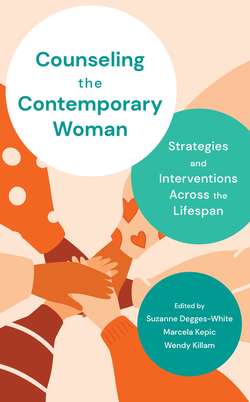Читать книгу Counseling the Contemporary Woman - Suzanne Degges-White - Страница 101
Case Vignette: Cara
ОглавлениеCara is a forty-seven-year-old woman who identifies as a multiracial, Hispanic woman. Before coming out as a bisexual at twenty-eight, Cara had married in her late teens and given birth to two children by the time she was twenty-five. Cara’s divorce was final shortly after her twenty-ninth birthday, and she was able to maintain primary custody of her children. Currently, Cara is in the middle of her second significant romantic breakup, as she and her partner of fifteen years, Sandy, have determined that their marriage is no longer viable. Sandy is a decade younger than Cara and had told Cara that she wanted to experience the world in ways that she had not been able to before, since she and Cara had moved in together when Sandy was only twenty-two. Cara recognizes that she is not the same woman she was in her early thirties and feels overwhelmed by Sandy’s departure, her adult children’s unexpected response of sadness at Sandy’s departure, and their placement of blame on Cara for the relationship breakup. Cara is bemused at her own sense of helplessness, fatigue, and sadness.
Cara decided to reach out to a counselor to help her make sense of the unexpected turn of events in her life. She arrived on time for the appointment and is eager to have someone help her figure out how to handle what feels to Cara like a total disintegration of her life as she knew it. When she entered the office of Sarah, her counselor, Cara sat down on the edge of the couch. When Sarah invited her to share what has brought her into counseling at this point in time, Cara burst into tears. Sobbing, she said to Sarah, “I thought I knew where my life was going. I have a decent part-time job, two grown children, and until a few weeks ago, I had a spouse that I thought I would spend the rest of my life with. Now, I’m looking at a second divorce. I’m worried that my kids will hate me forever. I’m worried that I won’t be able to pay my bills. I’m terrified that I’ll end up in a tiny apartment with not enough money for food. I haven’t slept through the night in months, my emotions are all over the place, and I feel like I’m either about to go off on people for no reason or just burst into tears like I did today. I don’t know who I am or where I’m going anymore.”
* * *
The stage of life known as “midlife” describes the years between somewhere around late thirties or early forties through the midsixties. Due to our lengthening lifespans, the midlife period grew into a discrete stage of life that precedes the “older adult years.” Roughly a century ago, this period of life would have been, effectively, the late adult years as life expectancy hovered around the early fifties (Grove & Hetzel, 1968). When this period of life began to take on its own identity, forty was the age at which midlife began according to many theorists (Jung, 1971; Levinson & Levinson, 1996; Neugarten, Moore, & Lowe, 1965; Sheehy, 1993). Midlife women are a sizable population, as women aged forty to sixty-four accounted for approximately 33 percent of the total U.S. female population in 2010 (U.S. Census Bureau, 2010). Further, midlife women make up the bulk of the client population for an exceptionally large number of counselors (Shallcross, 2012). Therefore, this chapter will provide a comprehensive review of the changes and challenges that women in this age group experience.
Although midlife was traditionally, and negatively, associated with a major life crisis (Jacques, 1965; Levinson & Levinson, 1996), it has also been described as a period of psychological awakening and significant inner development (Brehoney, 1996; Jung, 1971) and a time in which individuals may begin to direct their energy into generative pursuits (Erikson, 1968). These enduring but conflicting views may contribute to the ways women respond to their arrival in this period of life. While it would be ideal if women embraced the arrival of menopause with “postmenopausal zest,” a term Margaret Mead reportedly coined, not every woman is ready to experience these age-related changes regardless of the potentially positive outcome that awaits. Following is an overview of the ways the transition into and through the midlife period may influence women’s lives physically, cognitively, and emotionally.
